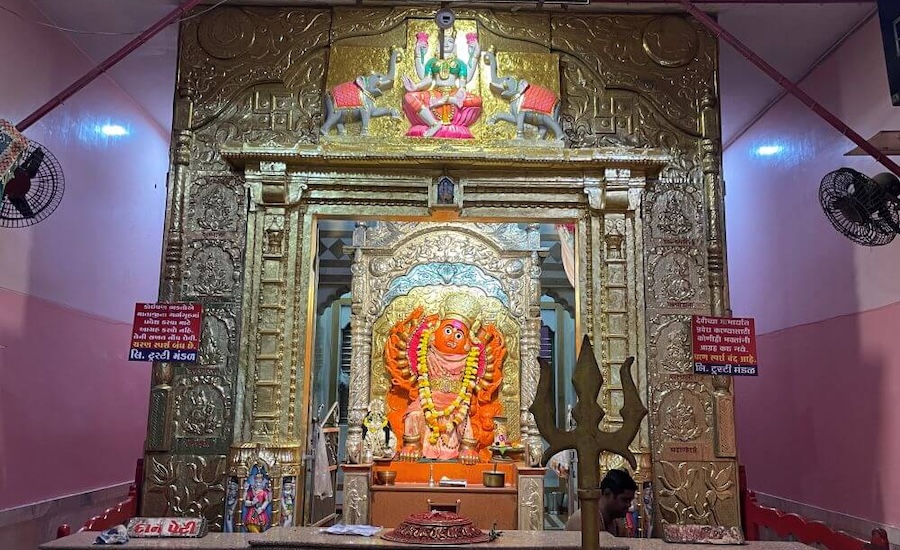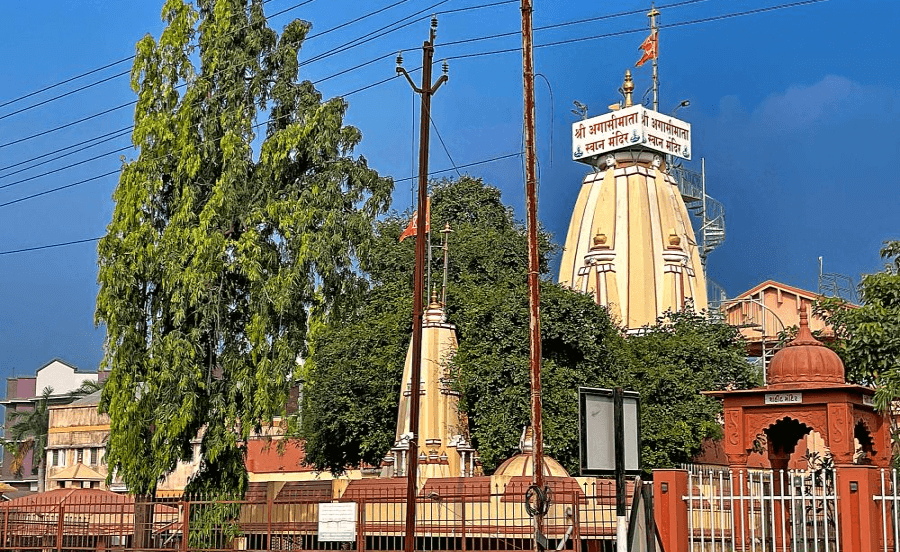
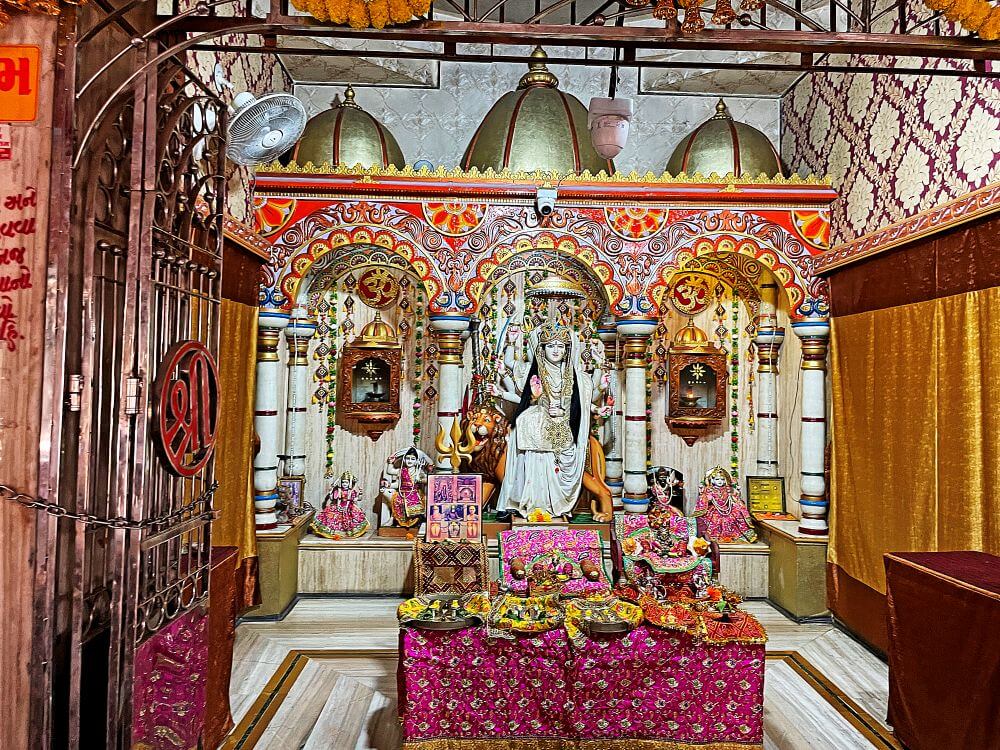 The Agasi (Aghanashini) Mata Swapna Mandir, located in Bardoli, Surat district, is one of Gujarat’s renowned temples with a history spanning over 400 years. The deity’s original name was Aghanashini, derived from ‘Agh’ meaning sorrow and ‘Nashini’ meaning destroyer—symbolising the goddess as the eliminator of sorrows. Over time, Aghanashini colloquially evolved into ‘Agasi’. Devotees believe that offering heartfelt prayers at this temple fulfills their wishes, and it is particularly revered for curing epileptic disorders in children brought here for blessings.
The Agasi (Aghanashini) Mata Swapna Mandir, located in Bardoli, Surat district, is one of Gujarat’s renowned temples with a history spanning over 400 years. The deity’s original name was Aghanashini, derived from ‘Agh’ meaning sorrow and ‘Nashini’ meaning destroyer—symbolising the goddess as the eliminator of sorrows. Over time, Aghanashini colloquially evolved into ‘Agasi’. Devotees believe that offering heartfelt prayers at this temple fulfills their wishes, and it is particularly revered for curing epileptic disorders in children brought here for blessings.
This temple, also known as the Adhya Sthanak Mandir, is uniquely situated under the canopy of three trees that have grown from a single root. It attracts hundreds of devotees from the region. 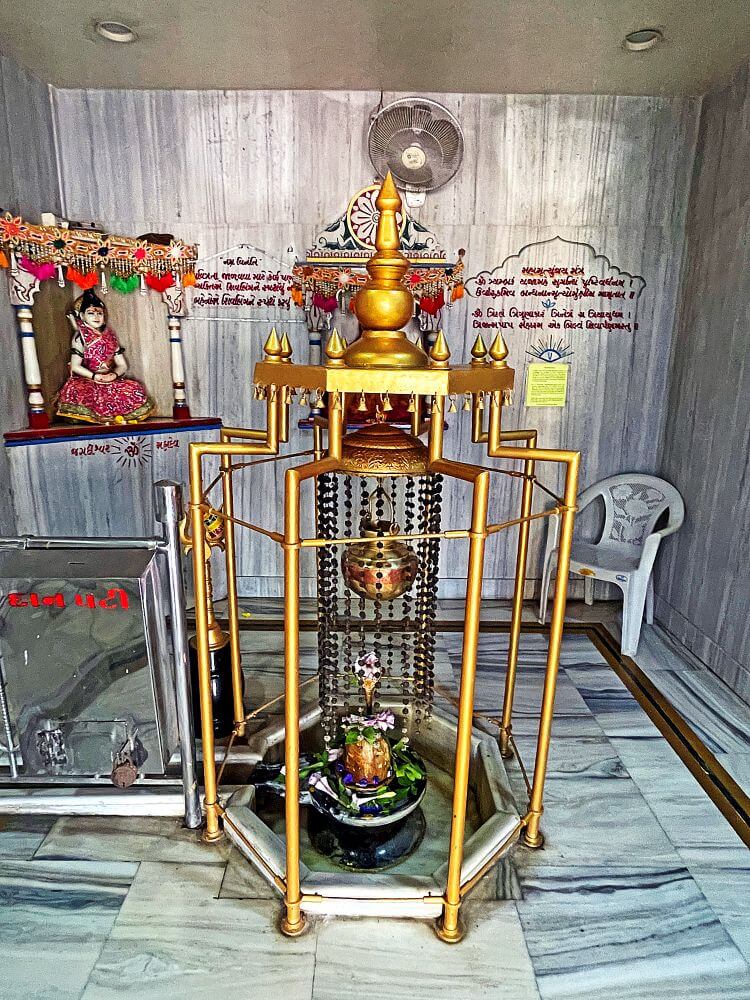 The temple celebrates all three Navratri festivals—Chaitra Navratri (from Gudi Padwa to Ram Navami), Sharadiya Navratri (from Ashwin Shuddha Pratipada to Ashwin Shuddha Navami), and Shakambhari Navratri (from Paush Shuddha Saptami to Paush Purnima)—with great enthusiasm and participation from countless devotees. The temple owes much of its modern establishment to Dave Bapu, its main spiritual guide and founder, who was fondly referred to as Dave Saheb.
The temple celebrates all three Navratri festivals—Chaitra Navratri (from Gudi Padwa to Ram Navami), Sharadiya Navratri (from Ashwin Shuddha Pratipada to Ashwin Shuddha Navami), and Shakambhari Navratri (from Paush Shuddha Saptami to Paush Purnima)—with great enthusiasm and participation from countless devotees. The temple owes much of its modern establishment to Dave Bapu, its main spiritual guide and founder, who was fondly referred to as Dave Saheb.
According to the legend behind the temple, In 1969, on the auspicious day of Dhanteras, Dave Bapu reportedly had a divine vision during the Brahma Muhurta (early morning hours). He saw a young girl, aged about six or seven, dressed as a goddess, pointing towards the three conjoined trees near the site. She instructed him to establish a temple under the trees without cutting a single branch. Inspired by this vision, Dave Bapu convened a meeting with prominent locals and initiated the construction of the temple, which was completed in 1975.
Situated east of Bardoli on the Surat-Dhuliya National Highway, the temple is set within a sprawling, walled complex with paved pathways. Constructed from white marble, the temple features jagati (an elevated plinth), and its design includes a sabhamandapa (assembly hall), a garbhagriha (sanctum sanctorum), circumambulatory path within the sabhamandapa and a tall shikhara (spire).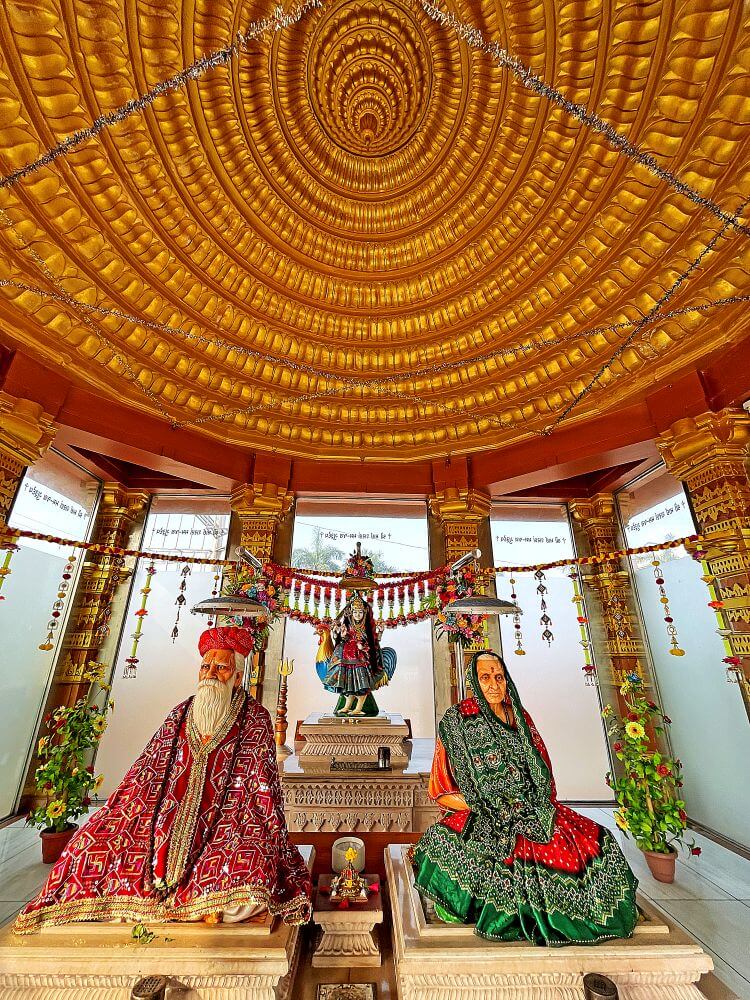 Upon ascending a few steps, devotees enter the sabhamandapa, where a marble shrine displays portraits of Dave Bapu and his wife, Sharadaba, placed on a raised platform to the right. The garbhagriha houses a magnificent standing marble idol of the goddess adorned with ornaments and mounted on a lion. The Ashtabhuja (eight-armed) idol is resplendent, holding various weapons and with a golden crown. Flanking the idol are three smaller deities and a trident (trishul). The sanctum also features intricate decorations and is considered the spiritual heart of the temple.
Upon ascending a few steps, devotees enter the sabhamandapa, where a marble shrine displays portraits of Dave Bapu and his wife, Sharadaba, placed on a raised platform to the right. The garbhagriha houses a magnificent standing marble idol of the goddess adorned with ornaments and mounted on a lion. The Ashtabhuja (eight-armed) idol is resplendent, holding various weapons and with a golden crown. Flanking the idol are three smaller deities and a trident (trishul). The sanctum also features intricate decorations and is considered the spiritual heart of the temple.
Adjacent to the sabhamandapa are smaller temples dedicated to Gayatri Mata and Ved Bhagwan on the left and Jagdishwar Mahadev on the right, accessible from the circumambulatory path (pradakshina marg). Inside the Gayatri Mata and Ved Bhagwan temple, on an elevated marble pedestal, stands a graceful idol of Gayatri Devi, enshrined in a beautifully decorated marble canopy. Flanking the central idol are two glass cases on either side, each housing books of the Vedas. Unique sculptures personifying the four Vedas are a significant feature of this temple: Rigveda represented as a white-coloured figure with two arms and a donkey’s face (girdabhmukhi). It holds a rosary (japamala) in one hand and a sacred text in the other. Yajurveda depicted with two arms and an ajmukhi (goat’s face). This idol holds a rosary in one hand and a chakra (discus) in the other. 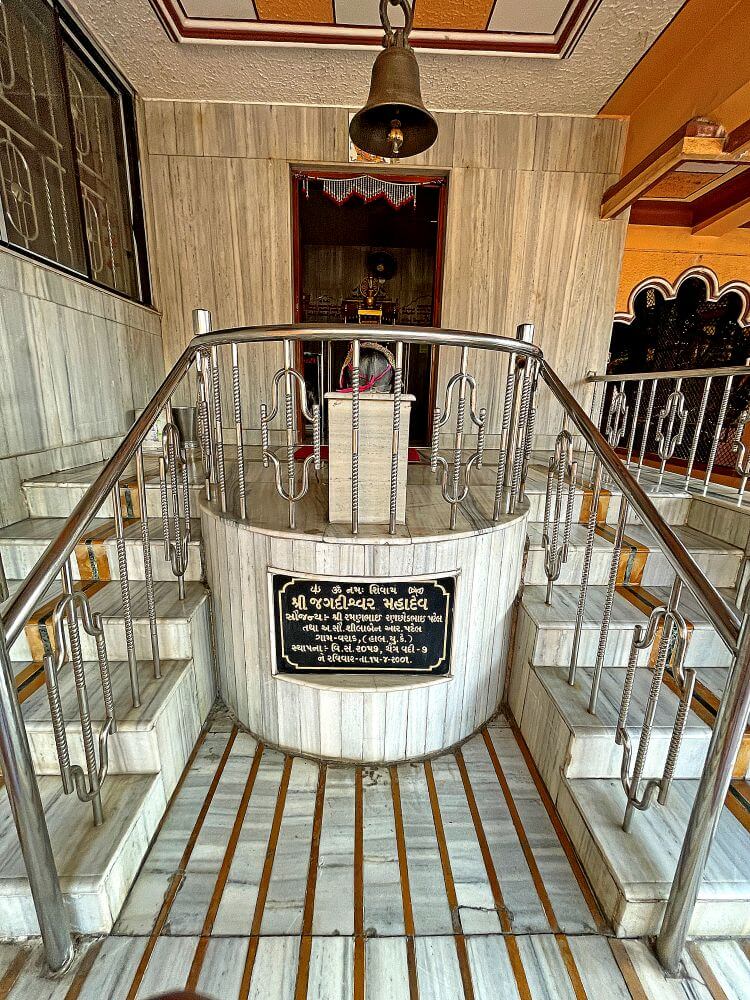 Samaveda portrayed with a horse’s face (ashvamukhi), holding a conch (shankha) in one hand and a rosary in the other. Atharvaveda shown as a white figure with a monkey’s face (vanarmukhi), holding a trident (trishul) in one hand and a rosary in the other.
Samaveda portrayed with a horse’s face (ashvamukhi), holding a conch (shankha) in one hand and a rosary in the other. Atharvaveda shown as a white figure with a monkey’s face (vanarmukhi), holding a trident (trishul) in one hand and a rosary in the other.
To the right of the sanctum sanctorum (garbhagriha), through the circumambulatory path (pradakshina marg), lies the entrance to the Jagadishwar Mahadev Temple. This temple can also be accessed directly from the courtyard. In the darshan mandapa (viewing pavilion) of the temple, there is an idol of Nandi (the sacred bull). Above the entrance to the sanctum sanctorum, on the lintel (lalatabimba), is a beautifully carved image of Lord Ganesha. Inside the sanctum, at the centre, resides a Shivalinga. A serpent’s hood forms a protective canopy over the Shivalinga, while a special overhead galantika (a decorative dripping vessel) continuously performs anointing (abhisheka) on the deity. The temple walls also feature smaller shrines. One enshrines an idol of Lord Shiva, while another houses an image of Goddess Parvati.
Adjacent to the Jagdishwar Mahadev Temple is the Adi Sthanak Temple (the original shrine) of Agasi Mata. Within this shrine, the goddess is represented in the form of a Yantra (sacred geometric diagram), enshrined in a small chamber (devli). To the left of this chamber lies a smaller shrine dedicated to Sheetala Mata, a goddess revered for her healing powers.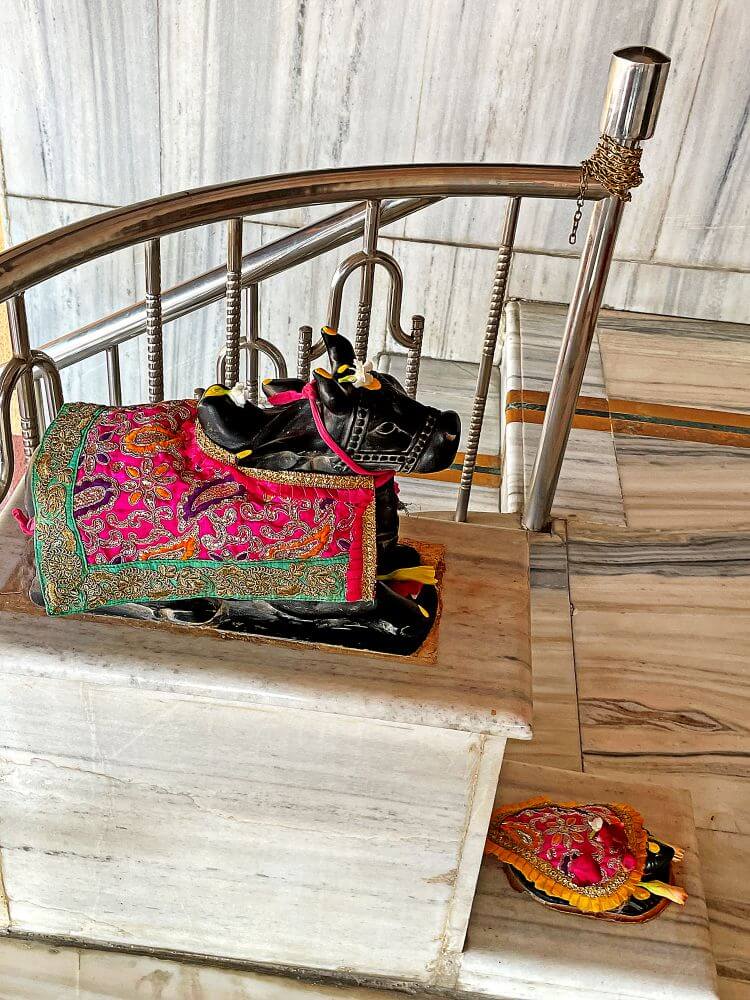 Additionally, to the left of the temple, there is a unique tree, where three distinct trunks have grown from a single root, symbolising unity and sacredness. Beneath this tree, in a small niche (devhara), resides a deity’s idol, making this spot particularly significant to devotees.
Additionally, to the left of the temple, there is a unique tree, where three distinct trunks have grown from a single root, symbolising unity and sacredness. Beneath this tree, in a small niche (devhara), resides a deity’s idol, making this spot particularly significant to devotees.
In the courtyard of the temple, directly opposite the Devi Temple, stands the Shri Yantra-Swarup Samadhi Mandir and the Bahuchara Mata Temple. This structure features an open assembly hall (sabhamandapa) and a sanctum sanctorum (garbhagriha). In front of the temple, on a pedestal, there is a large statue of a rooster, as the rooster (kukkut) is considered the vehicle of Bahuchara Devi. Inside the temple, on an elevated pedestal, are the idols of Dave Bapu and his wife, Sharadaba, who played a key role in the establishment of the temple. At the back of the temple, a striking image of Bahuchara Devi seated on a rooster is enshrined, showcasing her divine presence.
The temple complex also includes a kukkutghar (rooster enclosure), symbolising the sacred association of the rooster with Bahuchara Devi. Nearby, there is also a Paduka Mandir dedicated to Devaraha Baba, a revered saint from Yamuna Bank, Vrindavan, Uttar Pradesh, further adding to the spiritual significance of the site.
The temple is open for darshan from 6:00 am to 12:00 pm and again from 3:00 pm to 9:00 pm. Morning aarti is performed at 7:00 am, while evening aarti is held at 7:00 pm. Devotees suffering from epilepsy or similar conditions often make vows (navas) at the temple. Upon fulfilment of their prayers, they release roosters in the temple complex as an offering. The temple’s foundation day celebration is held in the month of June. On this auspicious day, a Navchandi Yagna (a sacred fire ritual dedicated to Goddess Durga) is performed along with the chanting of the ‘Anand No Garbo’ mantra. This event draws devotees from the surrounding areas to participate in the rituals and seek blessings. The temple celebrates several grand festivals, including Navratri Utsav. All three Navratri festivals are marked with vibrant celebrations, with the Sharadiya Navratri holds special significance. On Dussehra, devotees bring Garbi (decorated earthen lamps or offerings), which are later immersed in the river at the festival’s conclusion. The temple also hosts Guru Purnima, Maha Shivaratri, Diwali, and other religious events. The Shravan month witnesses a variety of rituals and a large influx of devotees.
